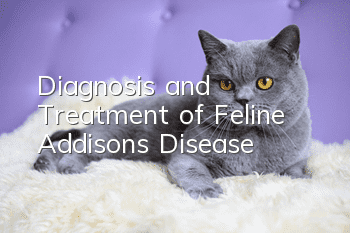Diagnosis and Treatment of Feline Addison's Disease

Adrenocortical insufficiency, referred to as Addison's disease, is a series of clinical syndromes caused by a deficiency of glucocorticoids or mineralocorticoids. Addison's disease in animals is a corticosteroid hormone deficiency. This is an unusual finding, as this deficiency unless taking drugs disrupts adrenal balance, but fortunately the disease can be controlled by corticosteroids, even if the cause of the deficiency is unknown.
For cats, adrenocortical insufficiency is relatively rare, with no relevant reports in China and no more than 40 cases reported abroad. But even so, we cannot take it lightly, we still need to have a basic understanding of it.
Diagnosis and treatment of feline Addison's disease
1. Symptoms
Feline hypoadrenocorticism is usually primary, with unknown cause, and can occur in cats aged 1-14 years (average age 4 years). The most common clinical symptoms are depression, dehydration, weakness, and hypothermia; collapse, bradycardia, and abdominal pain are less common.
2. Diagnosis
Addison's disease may appear in different forms. The inability to maintain normal blood glucose levels (which ultimately manifests as a dysfunction) may be a strong indicator of an insulin-secreting pancreatic tumor, which is an important test for Addison's disease before a major abdominal surgery.
Routine blood examination may reveal lymphocytosis and eosinophilia, as well as mild normocytic normochromic non-regenerative anemia. Most cats with primary adrenocortical insufficiency will have typical low blood pressure. Natremia, hypochloremia and hyperkalemia (sodium to potassium ratio <27:1), and prerenal azotemia.
3. Treatment
The most important aspect of treating adrenocortical insufficiency is the replacement of lost mineral corticosteroids. One way is to take oral fludrocortisone (Florinef). Fludrocortisone is usually given twice a day, and the dose is based on the patient's sodium and potassium blood tests. First, these electrolytes are monitored weekly. When concentrations stabilize, these blood tests will be repeated two to four times a year. Often it will be discovered over time and the dose of fludrocortisone will be gradually increased in order to control "Addison's" disease. Unfortunately, this drug is relatively expensive, and since fludrocortisone has glucocorticoid properties, like mineral corticosteroids, there is no need to use other medications.
Another way to treat this disease is to inject a drug called "DOCP" (commercially available)The product name is "Percorten-V"). This treatment is given approximately every 25 days. First, electrolytes should be measured before injection. Usually the testing process is gradually reduced, 1-2 times per year. Some neurologists believe that DOCP produces regulatory electrolytes better than oral fludrocortisone.
- How to take care of Chinchilla cat hair?
- Is your cat’s hair loss still serious in autumn? Maybe you have ignored these diseases?
- Why is the cat drooling?
- Does the owner know if a cat bite hurts?
- What should I do if there are black bugs on my cat?
- Will a pregnant cat suffer from morning sickness? Will a pregnant cat suffer from morning sickness?
- To prevent cat plant poisoning, there are benefits to growing cat grass
- What's up with the purring sound of the cat?
- How to train a Siamese cat to do somersaults?
- What are the signs that a pregnant cat will give birth?



